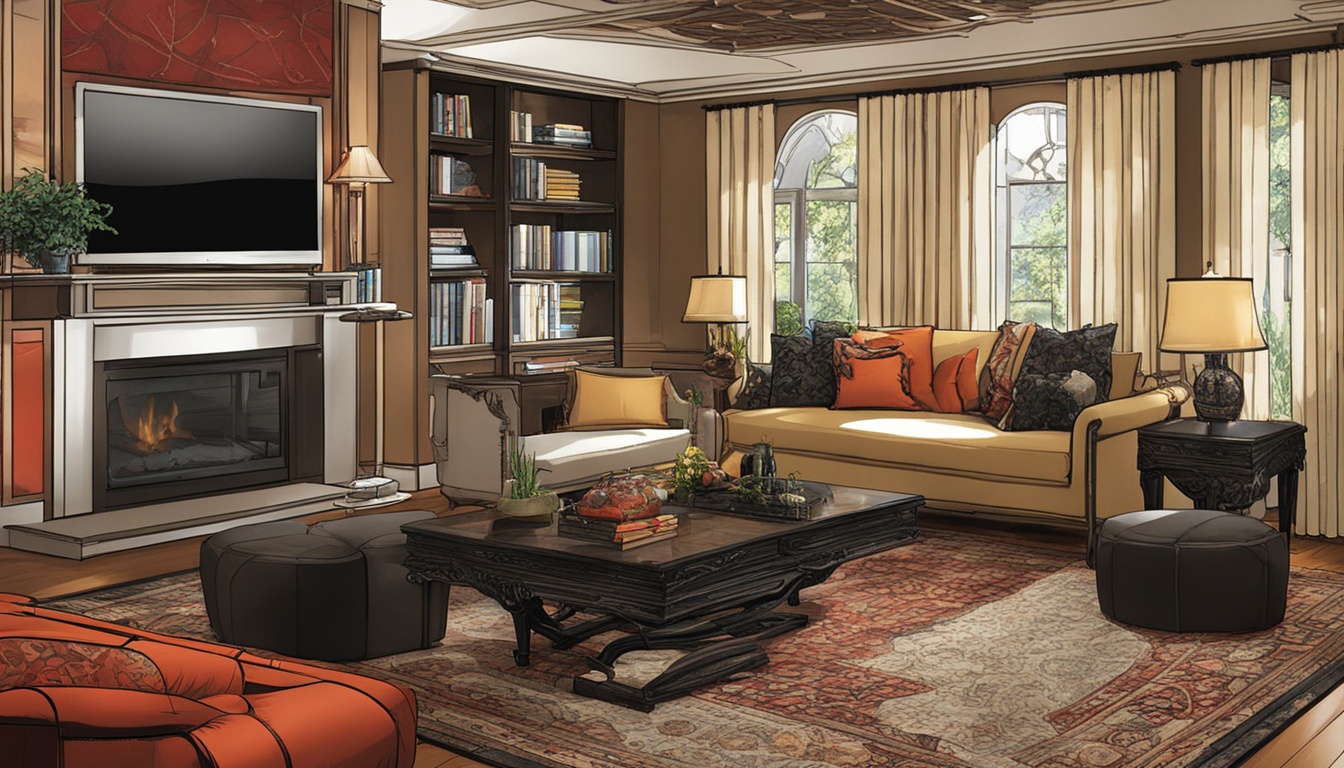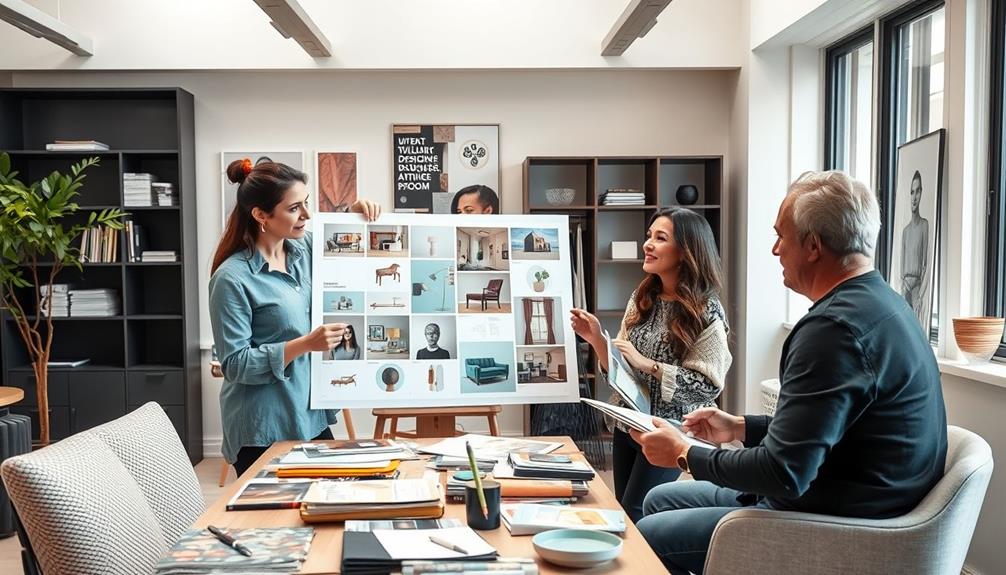To grow your interior design business, focus on diverse marketing channels like Google My Business and social media to boost visibility. Regularly create engaging content such as blogs and email campaigns to connect with clients and showcase your style. Enhance client experiences through personalized consultations and project updates, which builds loyalty. Network locally by participating in events and collaborating with businesses for referrals. Identify your niche to attract the ideal client. Finally, stay updated on industry trends to refine your services. There's much more to explore on effective strategies for your business growth. Invest in professional photography and create a portfolio that highlights your best work to attract potential clients. Additionally, consider offering special promotions or discounts to encourage repeat business and referrals. By implementing these effective interior design marketing strategies, you can establish a strong brand presence and position your business for long-term success in the industry.
Key Takeaways
- Leverage diverse marketing channels like Google My Business, SEO, and email marketing to enhance visibility and attract new clients.
- Create engaging content, such as blogs and social media posts, to establish authority and foster connections with potential clients.
- Build and nurture referral networks with local real estate agents and contractors to expand your reach and gain consistent referrals.
- Enhance client experience through personalized consultations and regular project updates to increase satisfaction and likelihood of repeat business.
- Actively participate in local events and community engagement initiatives to strengthen brand presence and connect with potential clients.
Understanding Marketing Channels

When it comes to growing your interior design business, understanding marketing channels is critical. A solid marketing strategy helps you reach potential clients where they are. While platforms like Instagram can boost audience connection with engaging content, don't rely solely on it for leads. Your ideal clients may not be active there, so diversify your approach.
To enhance your goal tracking and guarantee effective marketing, consider utilizing SMART criteria to define your objectives clearly.
A Google My Business account is essential for enhancing local visibility. Regular updates and positive reviews can greatly improve your search rankings, attracting new clients. SEO is another key tool; optimizing your website with fresh content and relevant keywords will improve your discoverability over time.
Consider starting a blog to not only boost your SEO but also establish trust with potential clients. By sharing valuable insights and showcasing your design philosophy, you demonstrate your expertise.
Additionally, don't underestimate the power of email marketing. Staying in touch with clients and prospects allows you to communicate important updates, fostering stronger relationships.
Content Creation Strategies

To effectively grow your interior design business, focus on content creation strategies that drive visibility and engagement.
Blogging regularly not only boosts your SEO but also attracts potential clients, while engaging email campaigns can strengthen your connection with them.
Additionally, leveraging social media content can amplify your reach and showcase your unique design style.
Blogging for Visibility
A well-crafted blog can be a game changer for your interior design business, boosting your visibility and attracting potential clients. By implementing effective blogging strategies, you can enhance your SEO and establish yourself as a trusted authority in the field.
Incorporating elements of a Healthy Lifestyle Blog can further enrich your content and draw in a wider audience interested in holistic living. Here are three key benefits of blogging:
- Increased Traffic: Fresh, keyword-optimized content draws organic traffic to your site, improving your search engine rankings and visibility among interior design clients.
- Credibility and Trust: Regularly publishing well-researched posts builds your reputation as a knowledgeable designer, making potential clients more likely to choose your services.
- Engagement: Including visually appealing images and client testimonials in your posts can greatly enhance viewer engagement, with posts featuring images receiving 94% more views.
Moreover, don't underestimate the power of social media. Sharing your blog content on platforms like Pinterest can attract even more visitors, as 80% of users seek home design inspiration.
By incorporating client testimonials and showcasing successful projects, you'll create compelling social proof that can help you convert readers into clients.
Start blogging today to elevate your interior design business.
Engaging Email Campaigns
Crafting engaging email campaigns is essential for keeping your interior design business front and center in clients' minds. Personalized emails can boost client engagement considerably, with studies showing they yield a six times higher transaction rate than non-personalized messages.
To maximize impact, schedule your email newsletters monthly to maintain consistent visibility and encourage referrals. Consider integrating insights from your client interactions to refine your approach, such as key factors in choosing a cleaning service that can help inform your service offerings.
Incorporate visually appealing design elements and high-quality images of your completed projects. Emails with images are opened 42% more than those without, making visuals vital for engagement.
Additionally, offering exclusive content—like design tips or early access to new services—creates a sense of value, encouraging subscribers to stay engaged and loyal.
Segmenting your email list based on client preferences and past interactions allows for tailored messaging. This strategy not only enhances open and click-through rates but also improves the overall effectiveness of your campaigns.
Social Media Content
Social media serves as a powerful platform for showcasing your interior design business and engaging potential clients. By implementing effective content creation strategies, you can attract new clients and expand your business. Here are three key strategies to contemplate:
- Showcase Transformations: Post visually appealing before-and-after images of your projects on platforms like Instagram. This not only highlights your design expertise but also grabs the attention of potential clients. Incorporating elements from a Cottagecore Home Office can also resonate with clients seeking cozy and serene workspace designs.
- Utilize Stories and Reels: Share behind-the-scenes glimpses of your design process through Instagram Stories and Reels. This humanizes your brand and fosters a deeper connection with your audience, helping to establish trust. Highlighting your approach to design thinking can further engage your audience and showcase your innovative solutions.
- Encourage User-Generated Content: Ask satisfied clients to share photos of their completed projects and tag your business. This leverages their networks, expanding your reach and credibility in the market.
Additionally, post regularly about industry trends, design tips, and inspiration to position yourself as a knowledgeable authority.
Don't forget to use relevant hashtags and geo-tags to boost discoverability, ensuring your content reaches the right audience. By focusing on these strategies, you'll effectively enhance your social media presence and marketing for your interior design business.
Enhancing Client Experience

Creating an exceptional client experience is essential for the success of your interior design business. By delivering a seamless design process, you can see a 70% increase in client referrals. Engaging clients with regular updates and check-ins can enhance satisfaction, boosting retention rates by up to 50%.
Here's a quick look at strategies to enhance client experience:
| Strategy | Benefit |
|---|---|
| Personalized Consultations | Elevated client perceptions |
| Regular Project Updates | Improved client satisfaction |
| Feedback Mechanisms | Valuable insights for future projects |
| Efficient Project Management | Reduced delivery times by 25% |
| Thoughtful Follow-ups | Increased repeat business by 30% |
Implementing feedback mechanisms, like post-project surveys, not only enhances client satisfaction but also helps refine your services. Utilizing project management tools streamlines operations, allowing you to create a more efficient and stress-free experience. When clients feel valued throughout the process, they're more likely to refer you to others and return for future projects. Focus on these strategies to elevate your client experience and watch your business thrive.
Networking and Local Outreach

To grow your interior design business, it's essential to focus on networking and local outreach.
Engage with local events and build referral networks with complementary businesses, like real estate agents and contractors, to expand your reach.
Building Referral Networks
Building a strong referral network is essential for growing your interior design business. By connecting with other local businesses, you can tap into a steady stream of potential clients.
Here are three effective strategies for building referral networks:
- Collaborate with Upstream and Downstream Businesses: Partner with real estate agents and contractors who can refer clients to you. This mutual relationship enhances your client acquisition strategy.
- Engage with Local Networking Groups: Actively participate in community events and industry gatherings. Establishing relationships with potential referral partners fosters a sense of community and increases your visibility.
- Implement a Referral Program: Create incentives for existing clients and partners to refer new clients. This not only boosts word of mouth but also encourages ongoing referrals, making your business top-of-mind.
Don't forget to regularly thank and acknowledge your referral partners for their support.
Strong relationships with local businesses greatly increase the likelihood of continuous referrals.
Local Event Engagement
Engaging with your local community can open doors to new opportunities and clients for your interior design business. Hosting local events, like open houses or design workshops, allows you to showcase your expertise while directly interacting with potential clients. These events enhance your visibility and build trust within the community, aligning with the goal of cultural celebrations and themes relevant to your audience.
Don't underestimate the power of networking opportunities. Joining local organizations, such as the Chamber of Commerce, connects you with fellow business owners and potential clients. These relationships can lead to valuable referrals and collaborations.
Actively participating in community events, such as charity fundraisers or art exhibits, not only demonstrates your commitment to the area but also promotes your design services to attendees.
Consider utilizing local Facebook groups to engage in design discussions. This can enhance your brand's visibility and connect you with people actively seeking design advice or services. By being present in these discussions, you cement your reputation as a knowledgeable local resource.
Incorporating these strategies into your business plan can greatly boost your community engagement and ultimately help grow your interior design business.
Collaborating With Businesses
Collaborating with local businesses can greatly elevate your interior design practice. By building relationships with referral sources like builders and real estate agents, you can enhance client acquisition through mutual referrals. Engaging with your community aligns with the organization's core values and objectives and can lead to more meaningful connections.
Here are three effective strategies to contemplate:
- Join Local Networking Events: Attend meetings organized by the Chamber of Commerce or other local networking groups. This is a fantastic way to expand your business connections and increase your visibility within the community.
- Host Joint Events: Collaborating with local businesses for joint events or promotions can greatly boost brand awareness. These events create a sense of community and can lead to new client opportunities.
- Leverage Social Media: Engage with local Facebook groups to connect with potential clients. Showcase your work and participate in discussions that enhance your brand's visibility.
Additionally, implementing a referral program that incentivizes past clients and local partners can encourage word-of-mouth marketing.
Niche Identification

Finding your niche in interior design is essential for standing out in a competitive market. By focusing on a specific style, client type, or project type, you can streamline your marketing efforts and attract your ideal clients. A well-defined niche not only positions you as an expert but also enhances client satisfaction, leading to referrals and repeat business.
Here's a quick overview of potential niches:
| Niche Type | Benefits |
|---|---|
| Sustainable Design | Aligns with eco-conscious clients |
| Luxury Residential | Attracts high-end clientele |
| Commercial Spaces | Caters to business needs |
Research shows that 70% of clients prefer hiring specialists over generalists in the interior design industry. Consequently, identifying your niche can differentiate you from competitors. Once you've chosen your niche, communicate it clearly through your marketing channels, like social media and your website. This helps potential clients quickly grasp your expertise and the unique value you bring to their projects. Embrace niche identification, and watch your business thrive in a focused manner.
Leveraging Existing Relationships

Building strong relationships with your existing clients can be a game changer for your interior design business. Retaining these clients costs considerably less than acquiring new ones, making it essential to nurture those connections.
By focusing on your existing clients, you can boost repeat business and encourage client referrals, which are invaluable for your growth. Engaging in regular check-ins can also help strengthen these relationships by reminding clients of the positive experiences you've provided.
Here are three effective strategies to leverage these relationships:
- Regular Check-Ins: Schedule updates or check-ins with past clients. This can increase the likelihood of repeat business by up to 60% and keeps you top of mind for future projects.
- Celebrate Milestones: Acknowledge anniversaries or project completions. Celebrating these milestones can prompt clients to think about new projects and refer friends or family.
- Inform About New Offerings: Keep your clients informed about new interior design services. Familiarity and trust can considerably enhance their likelihood of engaging with you again.
Continuous Learning and Development

Nurturing client relationships is only one piece of the puzzle in growing your interior design business; continuous learning and development play a key role as well. Staying updated with the latest trends, technologies, and design principles is essential for enhancing your service offerings and client satisfaction.
Engaging in professional development through certification courses not only helps you maintain necessary credentials like NCIDQ but also guarantees you comply with industry standards. Emphasizing tailored solutions for unique client needs can further enhance your reputation and service quality, aligning with a commitment to innovation in design excellence innovative products and ideas.
Flexible online courses and workshops allow you to acquire new skills, such as 3D rendering and software proficiency, which clients increasingly demand. Establishing a regular schedule for these activities can dramatically improve your expertise and business performance.
Additionally, participating in industry events and trade shows fosters valuable networking opportunities and knowledge sharing. Here, you'll expose yourself to innovative products and ideas, helping you stay competitive in a rapidly evolving market.
Effective Direct Mail Tactics

In today's competitive landscape, effective direct mail tactics can set your interior design business apart from the rest. By implementing these strategies, you can boost your brand awareness and engage potential clients more effectively.
- Use Targeted Mailing Lists: Focus on specific demographics, like new homeowners, to guarantee your message reaches those most likely to need your services. This increases your chances of engagement.
- Personalize Your Outreach: Incorporate handwritten notes or postcards in your direct mail campaigns. This personal touch can elevate your open rates by up to 50%, making recipients feel valued and more inclined to respond.
- Include a Strong Call-to-Action: Make it easy for recipients to take the next step. Whether it's scheduling a consultation or visiting your website, a clear call-to-action can drive response rates noticeably—up to 45% of recipients will act after receiving a direct mail offer.
Conclusion
In today's competitive landscape, many believe that great design alone leads to success, but that's only part of the equation. You need to master marketing, enhance client experiences, and build strong relationships to truly thrive. By focusing on these areas, you can elevate your interior design business beyond just aesthetics. Embrace continuous learning, identify your niche, and leverage every connection. When you combine creativity with savvy business strategies, you'll unearth the potential for remarkable growth and lasting success.









